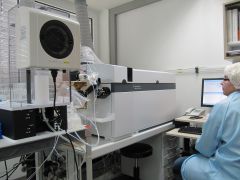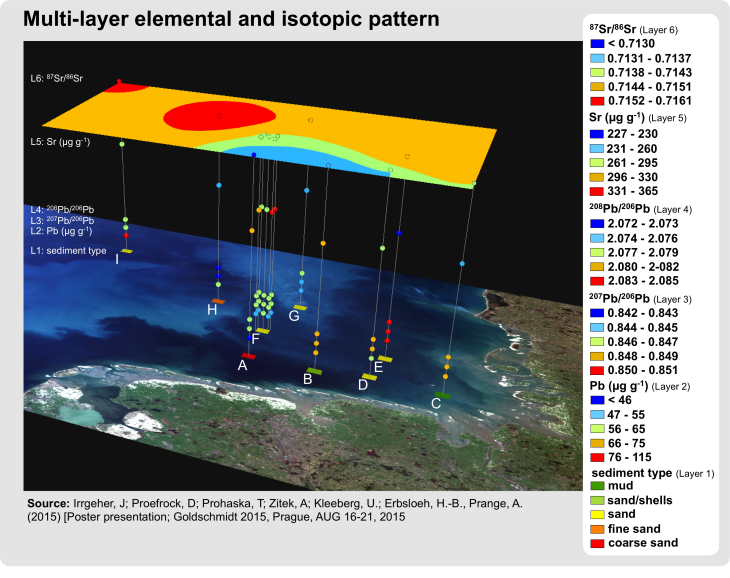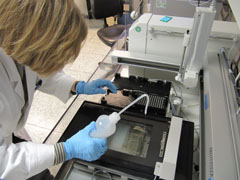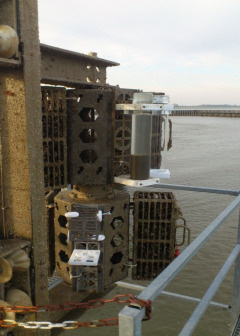Research Topics
Determination and evaluation of contaminants and their effects
Mission: The characterisation of priority and emerging contaminants, in particular heavy metals and element species, as well as their potential hazardous effects in coastal and marine environments using integrative sampling techniques.

The challenges of today’s environmental chemical analysis originate from the enormous diversity of man-made, highly potent chemicals, which often show persistence as well as additive effects in unknown, complex cocktails. The majority of these new substances is not yet monitored, regulated and their toxicological properties are not yet completely clarified.
Our focal points are the application and continuous development of multi-element analytical methods and hyphenated techniques in order to detect and determine traces of elements and element species of still emerging concern such as Tin- and Arsenic species as well as novel diagnostics e.g. Gadolinium species.
We can analyse a broad spectrum of elements which has to be merged to a certain pattern of elements (fingerprints). Characteristic pattern help to identify sediment provinces and give hints for the source, fate, and distribution of contaminants, suspended matter, and sediments.

T. Prohaska, J. Irrgeher, A. ZItek and N. Jakubowski, eds., Sector Field Mass Spectrometry for Elemental and Isotopic Analysis, Royal Society of Chemistry, Cambridge (2015).
Since its implementation in the early 1990s, the analysis of ‘non-traditional’ isotopic systems via MC ICP-MS (multicollector inductively coupled plasma mass spectrometry) has developed as promising and powerful technique. MC ICP-MS impresses because of the analytical ease mainly due to reduced sample preparation required and high sample throughput as well as its capabilities to ionize a very broad set of elements of the periodic table (click on figure to enlarge). Almost all elements of the PSE can be analyzed and thus the fields of application of MC ICP-MS range broadly.
It is for example possible to discriminate between natural sources (e.g. from geogenic variability) and anthropogenic sources (e.g. from mining or industry) of an element in different environmental compartments and to deduce the relative contributions of the sources. Additionally, artificially induced changes of the isotopic composition by introduction of an enriched tracer can also be investigated.
At Hereon (KBA), isotope research focuses on developing scientific tracer tools based on highly precise isotope ratios assessed in marine compartments by MC ICP-MS. A combination of different isotopic systems (e.g. Sr, Pb, Nd, Mo) is applied for the spatially structured description and evaluation of pollutants and nutrients in the German Wadden Sea including the tracing of sediments from river systems.
Our first results on isotopic system

T. Prohaska, J. Irrgeher, A. ZItek and N. Jakubowski, eds., Sector Field Mass Spectrometry for Elemental and Isotopic Analysis, Royal Society of Chemistry, Cambridge (2015).
As a pilot study selected sediment samples of our Wadden Sea campaign 2014 and the NOAH project sample fields (North Sea Observation and Assessment of Habitats) in the German Bight were analyzed regarding their Sr- anf Pb contents utilizing our new multicollector ICP-MS. The multilayer graph prepared with ArcGIS® shows significant variation of lead (Pb-208/Pb-206), (Pb-207/Pb-206) as well as strontium (87Sr/86Sr) and δ (Sr-88/Sr-86 SRM987) isotope ratios. This indicates possible different sources of the sediments. Further steps will be a area - wide analysis of the German Bight in order to detect further sources and origins to find contamination hot spots. Further information can be find at the poster presented during the Goldschmit conference 2015 in Prague. Publications -> Poster

Sample preparation for gel electrophoresis (Photo: Heike Helmholz/Hereon)
Contaminants affect organisms at different levels of biological organisation. Obvious and massive impacts such as morphological lesions or a population decrease could be observed earlier, in a prognostic approach at lower levels of organisation. In particular the measurement of changes at the protein level provides the chance of an early recognition of such responses directly at the molecular level.
Therefore we utilise transplanted mussels as indicators for responses to environmental, especially chemical, stress. Sophisticated bioanalytical methods in combinations with molecule-specific mass spectrometry are use to detect variations in protein expression profiles (proteomics). Furthermore we use established physiological indices to evaluate the fitness of our transplanted mussels.
Integrative sampling techniques (passive and active sampler)

Sampling station Cuxhaven (Photo: Daniel Pröfrock/Hereon)
Since 2011 we maintain two experimental platforms within the COSYNA network to support the development and the field testing of new integrative sampling techniques (different types of passive and active sampling devices). One station is located near Helgoland as a part of the underwater experimental site “MarGate”, while the second station is located at the “Seebäderbrücke” in Cuxhaven. For both stations a logistic concept has been developed allowing the continuous deployment of the different sampling devices as well as their regular sampling after four to six weeks.
In parallel regular spot sampling of the water phase as well as sampling of SPM using specific traps were performed to validate the results measured with the integrative sampler and to cover all relevant marine environmental compartments (sediment, water, biota).
Currently a flow through chamber is under development allowing the integration of passive sampling devices into stationary Ferry Box systems. It will be tested at the station “Cuxhaven”. The simultaneous acquisition of oceanographic data such as salinity, temperature etc. at both experimental sites via the FerryBox system provides important information regarding the interpretation of the measured contaminant levels as well as measured potential effects.
